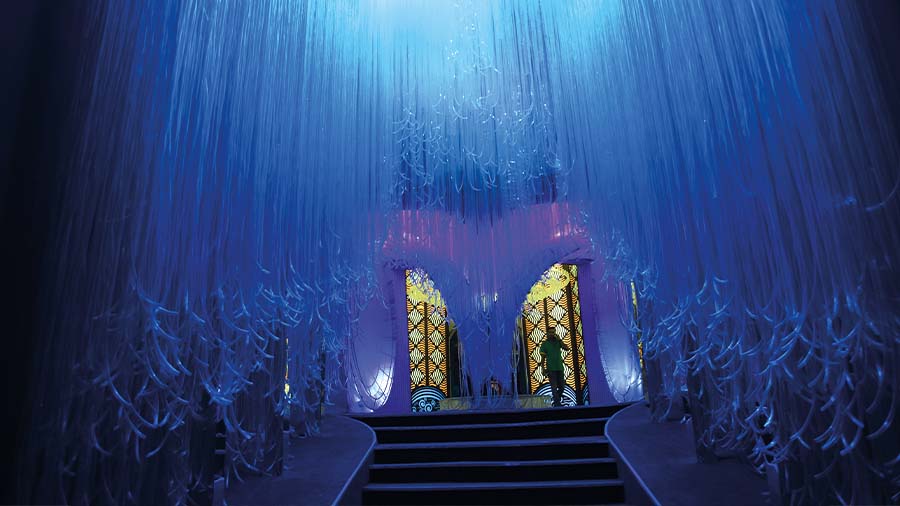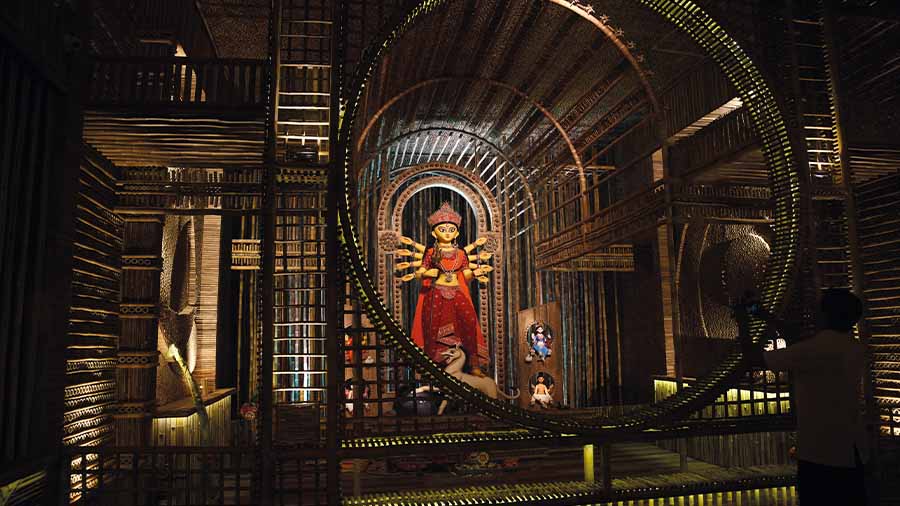THE ODE TO BEAUTY
Being an army child, I didn’t grow up in Kolkata. As a girl, Durga Puja meant holiday, fun, eating out with friends, especially in a small cantonment area. It was a month-long festivity, with rehearsals for children and adults leading up to the performances on Puja days. Meals were potluck lunches and dinners. We loved it because we were all together and would have fun sleepovers.
That was Puja for me till we came to Kolkata once, when I was a seven or eight-year-old. Even back then, the magnitude of Kolkata’s Durga Puja amazed me. It was a completely new kind of atmosphere, especially the crowds coming in just to see the idols. I really enjoyed it. I remember we used to have this little bag of loose change and we felt rich, because the bag was full and we could go and eat whatever we wanted, whenever we wanted. We had plans of which pandal to spend the morning at and which one to go to in the evening, wearing new clothes twice a day.
When I got married in 1974, I was introduced to a whole new world of Durga Puja, where we would go out at night with my mother-in-law (Amala Shankar) to the bonedi bari pujas in North Calcutta. I had never seen anything like that — all the women dressed in white saris with red borders, resplendent in their traditional jewellery, from grandmothers to granddaughters. It was such a fabulous sight, and so much a part of the aesthetics of Durga Puja.
PANDAL ART

Then came the transformation of the regular para pandals into works of art, where local artisans worked for months to display their craftsmanship on stunning temporary structures that took one’s breath away. I thought it was a beautiful idea. Most of the artwork, no matter the medium, was so creative.
Today, some of the pandals don’t even look like pandals, they look like permanent structures — an ethereal dream world fashioned out of bamboo, cloth, paper, jute, metal and whatnot. I often just stand and admire the sheer craftsmanship of our pandal-makers, and the wealth of creative ideas. It is incredible!
I have always preferred traditional idols, but now there are some gorgeous interpretations of the Durga idol. A testimony to how the idol-makers of Kumartuli and Patuapara have adapted to the changing times, experimenting and innovating every year to give shape to themes as varied as world peace and Harry Potter, agriculture and space research!
Thematically, our pandals have traversed a path far beyond the celebration of a religious festival. Today they address a variety of issues — social, cultural, and political. Having witnessed the entire scope of Durga Puja, from the simplicity of a small parar puja to the aesthetics of a bonedi barir puja to the artistic grandeur of the theme pujas, one can safely say no matter what your taste is and no matter what your temperament is, there’s something for everyone in Kolkata during Durga Puja.
WORLD’S LARGEST STREET ART FESTIVAL

Art has become an important component of Durga Puja, and it is heartening to see how well-known artists — sculptors, painters, installation artists — from the city are getting involved in the process of crafting pandals. The presence of well-known names provides a certain visibility to the art of our community pujas, but I feel local artisans who are putting in so much work should not get overshadowed.
Today, Durga Puja is regarded as the world’s largest street art festival. And not just the sponsors who pour in lakhs of rupees or celebrated artists who lend the local pandals a touch of grandeur, the art on the streets is very much the result of the magic our local artisans weave with their deft hands.
The various themes adopted by the pandals offer not just variety to pandal-hoppers but are also a splendid medium to raise and spread awareness about important issues of the day. One must give credit to the puja organisers who are conceptualising these themes and coming up with such incredible ideas on how to bring them to life in the most artistic ways.
And the audience of this artwork, even if they are ignorant about the theme in the beginning, have the curiosity to find out. The theme sparks an interest, and isn’t it great that art is able to spread a message? The people who come to see the pandals — walking the whole night, standing in queues for hours, commuting in packed Metros and buses — appreciate the effort that the puja organisers put in.
Yes, the crowds are often daunting for us, but I have been fortunate enough to be invited for judging pandals and the reason I keep saying ‘yes’ is because I can’t seem to let go of the opportunity to witness all this incredible art up close!
A GREENER, SAFER CELEBRATION

Today Durga Puja is regarded as the world’s largest street art festival. And not just the sponsors who pour in lakhs of rupees or celebrated artists who lend the local pandals a touch of grandeur, the art on the streets is very much the result of the magic our local artisans weave with their deft hands .
The other positive development in recent years is that along with adopting artistic themes, puja organisers are becoming aware of environmental and safety concerns at the puja venues. Earlier there would always be reports of some fire or the other at a pandal, but that fortunately has almost completely stopped. Organisers are using environment-friendly materials to erect the pandals, providing wide entry and exit points, keeping fire-fighting equipment at hand, and trying to lessen the use of plastic.
One hopes that all those thousands of people visiting these pandals are carrying back with them not just admiration and awe for the art and aesthetics but also an awareness about the importance of a greener, safer celebration. So, Durga Puja in Kolkata is not about art just for the sake of art but also using it to raise awareness.
While discussing Kolkata’s engagement with the arts during Durga Puja, one must also mention the fillip theme pandals provide to indigenous art forms — not just paintings and crafts, but also dance and music. There are pandals where you can experience a tribal village almost in its entirety. Local art forms are showcased, the artists are appreciated and it gives them an avenue for employment.
When talking about Durga Puja, how can one forget the lights? The whole city is wrapped in stunning light installations — much of it created in Chandernagore — and each panel contains a narrative. The lights have evolved and how! No longer satisfied depicting just animals or flowers or a fountain, many of them now tell stories relevant to the times.
So Durga Puja is an amalgamation of various art forms and artistic talents and what a picture it paints in the capital of West Bengal!
ART BEFORE OUR EYES

The run-up to Durga Puja offers the residents of Kolkata the unforgettable experience of witnessing empty parks or cluttered road corners transform into artistic dens before our eyes. The eyesore and inconvenience of piles of bamboo poles are forgotten when you see art taking shape right here, right now. The festival dresses up the city like a queen!
The aesthetics of Durga Puja is just not limited to the pandals, the idols and the lights. It is an intrinsic part of Durga Puja, whether it is in the sree that is made for the puja, or how the bhog is served to the Goddess or the intricate alpana that is etched on the platform where the puja is conducted.
It even spills over to the people and their sartorial choices. It always gladdens my heart to see young women in bright saris or traditional white saris with red borders and young men resplendent in dhuti-panjabi — it all adds to the aesthetic appeal of Durga Puja.
FESTIVAL FEVER

Durga Puja in Kolkata has now become like the Edinburgh Festival, where the whole city becomes the festival venue. And everyone wants to be here, because it’s an entire city caught up in a festive fever. You can see the traditional pujas at the bonedi baris and you can participate in the grand baroari theme pujas.
There is a reason why friends from other countries troop into the city during Durga Puja despite our warnings about the crowds. It is like going to the carnival in Rio De Janeiro. And, honestly, the traffic during those five days is so well managed in Kolkata that it is hardly an inconvenience.
A LABOUR OF LOVE
One of the most interesting aspects of this festival is that all the grandeur, all the hard work put in for months is all dismantled in a matter of a week. This fragility is very unique. And every year almost everything is new, because the audience expects something new.
But then again, we are used to bidding goodbye to the Goddess every year because we know that if she doesn’t go, she won’t come back. That thought prepares us for the inevitable dismantling of what is always a labour of love.
Nowadays, many pandals sell the artwork to businesses or tourists, which makes it not only economically viable and environmentally sustainable but also gives the artisans a sense of accomplishment and appreciation.
Durga Puja is unique in another way. It is a social festival much more than just a religious festival. The puja is at the heart of the festival but it is not the only thing. And that is the beauty of our festival. The two pillars of this festival are the tradition and the aesthetics and it is important that they continue to be strong.
And I can’t wait to see how this socio-cultural festival evolves in the years to come.
Tanusree Shankar is one of the leading dancers and choreographers of contemporary dance in India. She carries on the legacy of legendary dancer Uday Shankar through the Tanusree Shankar Dance Academy. She has also acted in several films, including The Namesake.
Excerpted from Durga Puja: The People’s Festival produced by The Bhawanipur Education Society College in 2019.
